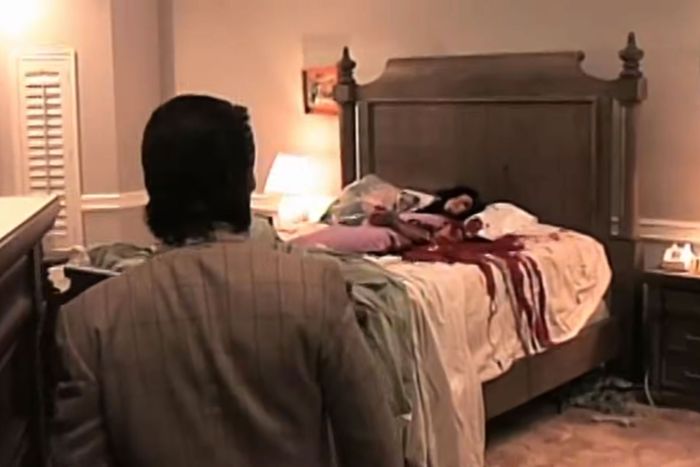
When the first V/H/S made its way to theaters and VOD in the autumn of 2012, it looked like a one-off curiosity, not the beginning of a regular showcase for exciting voices in horror. Roping together a handful of spooky short films all shot in the style of home videos, the omnibus project was clearly made to capitalize on the found-footage craze that Paranormal Activity had resparked a few years earlier. V/H/S was also steeped, of course, in the language of a more distant past: It was a Creepshow-style anthology of the kind that was last big in the ’80s and was named for a movie-watching technology that had gone obsolete around the turn of the 21st century. “Timeless” was not a word that leaped to mind while watching this collection of digital campfire stories. A sequel seemed about as likely as VHS itself mounting a comeback.
Yet here we are, roughly a decade later, and there are now six V/H/S movies and counting, directed by an ever-growing stable of rising and established filmmakers. Since moving to Shudder, the series has become an annual tradition, with a new crop of scary shorts arriving every October and breaking records for the streamer. The latest installment, V/H/S/85, which lands on Shudder today, continues this unlikely franchise’s ongoing stroll down memory lane with stories explicitly set during the Reagan years and filmed to look like they were shot then, too. Where once these movies seemed only vaguely retro in their format and framing, they’re now intentionally so. Each functions like a video flashback to a different era, aiming to send viewers on a nostalgia trip while sending shivers down their spines.
Truthfully, though, the appeal of V/H/S is indeed rather timeless. The fashions and references may change, the meaning of “video” may shift, but at heart, these movies are like classic short-story collections, the kind you might read by flashlight on a dark and stormy night. Like most anthologies, horror or otherwise, they can be hit or miss, though just about every one of the individual segments in the franchise is good for a scare or at least a laugh. Below, we’ve ranked all 31 of them from worst to best, leaving out only the feature-length spinoffs Siren and Kids vs. Aliens (neither of which are short nor shot in the found-footage style) and the Snapchat miniseries V/H/S: Video Horror Shorts. Consider this your guide to one of the most unexpectedly durable franchises in modern horror; it’ll remain comprehensive until at least next Halloween when V/H/S adds some late-’70s or early-2000s horror to its proverbial video-store inventory.
31-28.
“Tape 56” (V/H/S), “Tape 49” (V/H/S/2), “Vicious Circles” (V/H/S Viral), and “Holy Hell” (V/H/S/94)
Let’s just get this out of the way now: The wraparound segments are easily the most expendable part of any V/H/S movie. We could debate the relative quality of each, noting that Jennifer Reeder’s 94 entry is a cut above the rest, thanks to some creepy occult imagery. But all of them exist only to provide some unnecessary connective tissue between the vignettes, as though we needed to see someone pop a tape into a VCR to accept the anthology format. Thankfully, recent entries in the franchise have dumped the framing stories entirely, saving us all the trouble of scrubbing past them.
27.
“Dante the Great” (V/H/S Viral)
Abracadablah. In theory, ditching the home-video concept for a mockumentary approach was a fun wrinkle in the V/H/S formula. But this terminally silly tale of a magician with a man-eating cape doesn’t convincingly mimic the look or language of a talking-head documentary … and that’s before it ditches the, ahem, illusion entirely. (Who exactly is supposed to be filming the mayhem of the climax?) Director Gregg Bishop’s greatest magic trick was somehow parlaying one of the worst V/H/S shorts into a full-length version of one of the best; he’d later helm the “Amateur Night” expansion Siren.
26.
“Gorgeous Vortex” (V/H/S Viral)
It’s not difficult to understand why “Gorgeous Vortex” was excised from V/H/S Viral and only later released as an extra on the Blu-ray. Director Todd Lincoln (The Apparition) almost completely ditches found footage, with only a few grainy, unmotivated, surveillance-style shots preserving the theme. Beyond that, his wordlessly told tale of a secret society, a monster, and a woman out for revenge (possibly? maybe?) doesn’t make a whole lot of sense. It plays like a particularly “arty” perfume commercial — not a drag to watch per se, but also an easy cut.
25.
“Dreamkill” (V/H/S/85)
As if determined to fully put his brief tenure as a PG-13 Marvel hitmaker behind him, Doctor Strange director Scott Derrickson ramps up the nastiness, hard: The home-invasion murder scenes of “Dreamkill” are like something out of a particularly grimy, gory ’80s slasher. Unfortunately, they’re festooned to a shakily acted potboiler about a kid whose premonitory nightmares are supernaturally recorded to tape. Sinister it ain’t.
24.
“Bonestorm” (V/H/S Viral)
Is the title an intentional Simpsons reference? There are more scares in an average “Treehouse of Horror” segment than in this boneheaded battle between obnoxious teenage skaters and necromancing Tijuana cultists. Some of the GoPro footage is abrasive in the right way, but “Bonestorm” is generally about as wearisome as, well, a normal skating video. It’s hard to believe it was directed by Justin Benson and Aaron Moorhead, who would go on to make much trippier genre movies like The Endless and Synchronic.
23.
“Shredding” (V/H/S/99)
Pretty rudimentary in the scare department. Once the beyond-the-grave comeuppance arrives, this short is just standard shambling ghouls and raining blood. “Shredding” is more fun as a portrait of generational revenge, with Gen X rockers returning from the dead to punish pop-punk kids insufficiently respectful of their musical elders. Director Maggie Levin also offers a pretty spot-on imitation of Jackass-era music-TV aesthetics.
22.
“To Hell and Back” (V/H/S/99)
V/H/S literally goes to Hell … and it’s surprisingly underwhelming? There just isn’t a whole lot of terror or visual imagination in directors Vanessa and Joseph Winter’s Doom-style, rocky-wasteland conception of the underworld, and the joke that it’s bickering bros navigating the land of the damned quickly wears thin. Two big points in the segment’s favor: the monster effects viewed in quick glimpses and Melanie Stone’s spirited, amused performance as a witch agreeing to play guide for the heroes in exchange for a little notoriety back on Earth.
21.
“Total Copy” (V/H/S/85)
If the V/H/S series has a leading visionary, it’s probably David Bruckner, who made the original’s most influential segment and has creatively overseen the last three sequels. He returns to the director’s chair with “Total Copy,” a quasi-wraparound segment that takes the form of a made-for-TV documentary following the discovery of a shape-shifting extraterrestrial child hooked on American television. The setup is so intriguing (it’s like a public access version of The Thing) that it’s disappointing to see Bruckner steer it in the usual screaming monster-mayhem direction so many V/H/S shorts inevitably take. But the climactic, showboating long shot is impressive, and it concludes with a brilliant final image — a dark joke at the expense of ’80s hysteria about the corrupting influence of TV on our impressionable youth.
20.
“Second Honeymoon” (V/H/S)
The most mumblecore V/H/S short casts indie mainstays Joe Swanberg and Sophia Takal as a couple whose ramble across the American Southwest slowly takes on menacing undertones. Ti West, who scored double horror hits last year with X and Pearl, commits almost too well to the sightseeing tedium of a typical vacation video. The shocking twist would land harder if he better-seeded hints of trouble in paradise. “Second Honeymoon” is best appreciated in relation to the more kinetic horror shorts around it; every mixtape benefits from a palate-cleansing slow jam.
19.
“God of Death” (V/H/S/85)
A TV news crew is plunged into a hellish ordeal during an apparent earthquake in Mexico City. Stylistically, “God of Death” is among the most convincing of the new crop, with director Gigi Saul Guerrero capturing the harsh texture of ’80s-broadcast video. The belated emergence of a supernatural threat almost seems superfluous; the crumbling-building carnage is harrowing enough (if debatably tasteless in its evocation of real-life natural disasters) without a demonic dimension.
18.
“10/31/98” (V/H/S)
Long before its leading directors took over the Scream series, the filmmaking collective Radio Silence mopped cleanup for the first V/H/S with this story of frat boys stumbling into a real-life haunted house on Halloween night. “10/31/98” isn’t really much more than a collection of nifty, practically achieved poltergeist effects, though its depiction of dude-bros trying to behave valiantly and save the day is an interesting contrast to the other segments of the movie, most of which involve predatory and/or caddish men.
17.
“Tuesday the 17th” (V/H/S)
Tales From Beyond the Pale co-creator Glenn McQuaid unleashes a Jason Voorhees whose appearance is concealed not by a hockey mask but a squiggly blur of video noise, corrupting the handheld footage of him stalking college kids through the woods. More than the glitchy monster or the solid kills, what distinguishes McQuaid’s camcorder slasher movie is the spooky ambivalence of its heroine, a Final Girl so thirsty for revenge against the killer that she’s willing to use her own friends as bait.
16.
“Phase I Clinical Trials” (V/H/S/2)
Returning to the franchise after directing the original’s framing story, Adam Wingard (The Guest, Godzilla vs. Kong) casts himself as a hapless every-dude whose new prosthetic eye — actually a camera wired to his brain — gives him the unwelcome ability to see ghosts. Both the Los Angeles pad-with-pool setting and a gratuitous sex scene lend the whole segment an amusingly trashy amateur-porn vibe. Mostly, though, Wingard deploys his first-person POV gimmick for the purposes of cheaply effective jolts. It’s a good time for funhouse fans at least — think Jump Scare: The Movie.
15.
“The Gawkers” (V/H/S/99)
American Pie meets Rear Window meets Greek mythology in Tyler MacIntyre’s cautionary tale of adolescent voyeurism gone wrong. Like a preteen version of the original film’s “Amateur Night,” the segment flips the leering gaze of a group of young horndogs about to pay a dear price for their objectifying ways. No surprises here, but the way the carefree peeping-tom comedy morphs into a miniature creature feature is crudely satisfying.
14.
“Parallel Monsters” (V/H/S Viral)
Much more unpredictable is Timecrimes director Nacho Vigalondo’s sci-fi curiosity, in which two versions of the same suburban scientist open a door to each other’s identical realities, only to discover that they’re not so identical after all. The ending could be wittier, but this is one of the more singular V/H/S entries — for its outlandish effects, its hint of farcical humor, and for how Vigalondo uses the format to indulge one of his favorite themes, the wandering attentions of restless family men.
13.
“TKNGD” (V/H/S/85)
Anyone who’s ever rolled their eyes through particularly pretentious performance art will get a kick out of Natasha Kermani’s short but bracingly viscous entry, framed as the televised spoken-word presentation of an artist wading into a new VR world that’s more dangerous than she realizes. The deliberately primitive computer graphics clash potently with the exaggerated low-budget splatter — it’s the fabled dread of new technology made grossly, viscerally immediate. The punchline is perfection.
12.
“Ozzy’s Dungeon” (V/H/S/99)
Flying Lotus probably wins the award for nuttiest entry in the whole V/H/S series with this deranged revenge thriller built around a punishingly difficult Double Dare-style childrens’ obstacle course. TV veterans Steven Ogg and Sonya Eddy deliver hysterically profane, outsized performances, while the sadistic show-within-the-short runs Nickelodeon nostalgia through a curdling Adult Swim nightmare filter. (The way the rapper-turned-director keeps cutting to the same gnarly injury over and over again is grotesquely hilarious.) As is sometimes the case with V/H/S shorts, the late addition of a supernatural angle doesn’t seem entirely necessary — though in this case, it does facilitate a terrific final image.
11.
“The Empty Wake” (V/H/S/94)
Adam Wingard’s regular screenwriter, Simon Barrett, takes a page from the Paranormal Activity playbook by setting up stationary cameras in a funeral home, then generating suspense by switching angles as the guest of honor proves less … sedentary than expected. While the worst found-footage horror tends to cheat its way around the limitations of the gimmick, Barrett embraces them; the locked vantage of those three cameras — never offering a complete view of the room — enhances the claustrophobic tension of his simple but effective campfire story. Great makeup effects, too.
10.
“A Ride in the Park” (V/H/S/2)
Eduardo Sánchez made the most iconic and maybe the all-time greatest found-footage horror movie ever with The Blair Witch Project. But his V/H/S segment, co-directed with Gregg Hale, is a much more explicit and less suggestive affair: a zombie apocalypse thriller filmed entirely from the perspective of a mountain biker’s helmet camera, which becomes something like Zombie Vision once our pedaling hero involuntarily switches to the hungry horde’s side. It’s an expertly choreographed blast of undead mayhem, squashing the flesh-chomping violence and bumbling slapstick of a George Romero movie into a few splattery-good minutes. There’s even a touch of poignancy to the ending — an unexpected turn for a short that otherwise plays like a particularly gory, darkly funny Gatorade commercial.
9.
“Terror” (V/H/S/94)
Of all the human monsters devoured by actual monsters across the V/H/S series, few have deserved their fate quite as much as the white-supremacist militiamen of 94’s closing chapter. Pushing past I Love the ’90s nostalgia, writer-director Ryan Prows echoes the real-life horror of racist extremists like Timothy McVeigh, all while adopting the shrewd BlacKkKlansman tactic of making them look simultaneously dangerous and moronic. “Terror” arguably rushes too quickly through its righteous payoff; we deserve an ocean of skinhead blood, not a mere spray. It’s still enormously gratifying, of course … at least until you remember that there’s no shrieking vampire making short work of our real-life white-power deplorables.
8.
“No Wake” (V/H/S/85)
The best installment of the new V/H/S is a tricky structural marvel, spread out across two distinct chapters separated by other, unrelated vignettes. It would be unfair to say much about the plot of “No Wake,” except that it chronicles a lake vacation that goes horribly awry. But writer-director Mike P. Nelson, who made the Wrong Turn remake, plays with perspective in diabolical ways — first via an intense set piece that chaotically limits our view of the threat, then with a swap to the running camera of an entirely different character. Death is where most of the V/H/S shorts end. Let’s just say that’s not exactly the case with this twisty portrait of American bloodlust.
7.
“Suicide Bid” (V/H/S/99)
Take away the technological hook, and many V/H/S shorts are really just variations on the old E.C. Comics formula, in which someone pays a ghoulish price for their sins. “Suicide Bid” might be the ultimate example: Following a sorority hopeful who agrees to spend the night in a coffin, oblivious to the fact that the sisters have no intention of accepting her pledge, it’s a classic bit of graveyard retribution in the Tales From the Crypt mold. It’s also expertly staged by Johannes Roberts, director of the underrated Strangers sequel, who amps up the claustrophobic dread of the buried-in-a-box scenario. The ending is easy to anticipate and no less fiendishly pleasing for it; seeing the karmic scales balanced this well deserves a hearty Cryptkeeper cackle.
6.
“The Sick Thing That Happened to Emily When She Was Younger” (V/H/S)
In addition to starring in “Second Honeymoon,” Joe Swanberg directed one of the creepiest V/H/S installments, presented as a series of Skype calls between a woman convinced her apartment is haunted and her long-distance boyfriend. The big twist, which subverts all kinds of audience assumptions (including the exact kind of scary movie you’re watching), is deeply disturbing. Even without it, though, Swanberg’s entry would be worth it for how well he exploits the spacial possibilities of his chat-box setup, scoring big scares by drawing our eyes to the stretches of dark, empty space over his heroine’s shoulder. Call it a test balloon for ScreenLife, the laptop-horror genre Unfriended would run with a couple years later.
5.
“Storm Drain” (V/H/S/94)
Chloe Okuno (Watcher) nails the look and feel of ’90s local news with this inspired tale of a scoop-hungry TV reporter who gets more than she bargained for while investigating an urban legend and a group of people living in her town’s sewer system. “Storm Drain” is devious satire, ruthlessly skewering the sham altruism of its Pulitzer-hungry protagonist. And if it clearly lifts its sick joke of an ending from Joe Dante’s The Howling, it also fruitfully nods to Rob Bottin’s spectacular practical-effect work from that classic in the conception of its awesome main attraction. Hail Raatma!
4.
“Slumber Party Alien Abduction” (V/H/S/2)
Though director Jason Eisener would eventually spin the premise out into a full feature with last year’s conventionally shot Kids vs. Aliens, it’s his original found-footage short that’s really worth seeing. “Slumber Party Alien Abduction” dots its opening stretch of adolescent tomfoolery with warning signs, har har, of the extraterrestrial terror to come. (There’s a great shot involving something lurking and only briefly glimpsed in the lake.) It then transforms into one of the scariest and most inventively staged V/H/S segments with Eisener using the handheld camera to get us uncomfortably close to the close encounter of the third kind and realistically, nightmarishly blowing out both the volume and the picture during the blinding, deafening invasion. Only sensitive dog lovers should skip this ride.
3.
“The Subject” (V/H/S/94)
Okay, so the digital video looks more 2014 than 1994. Set aside that minor quibble and “The Subject” is a high-octane triumph of Frankensteinian pathos, body horror, and adrenalized action-movie lunacy. Unfolding mostly from the mechanized eyes of a woman who’s been transformed into a cybernetic abomination by a mad scientist, it’s The Modern Prometheus as a simultaneously outrageous and tragic first-person shooter; somehow, the jaw-dropping orgy of police-versus-robot havoc never detracts from our empathy for the obscenely transformed main character. In terms of pure holy-shit intensity, “The Subject” is eclipsed only by the other V/H/S installment from director Timo Tjahjanto. Keep reading …
2.
“Amateur Night” (V/H/S)
In many respects, David Bruckner’s lead-off segment, later expanded into the feature-length Siren, set the template for the whole V/H/S series. Following a group of prowling guys who try to take advantage of the wrong inebriated woman, it exemplifies (and arguably perfects) the franchise formula of mundane home-video setup leading into bloody, feverish payoff. But few of the directors who would join V/H/S over the years that followed introduced a more memorable creature — a birdlike demon who oscillates from purring affection to ravenous rage — or so skillfully tracked the running bodies captured by a running camera. Beneath the monster-movie thrills, “Amateur Night” uses the first-person footage to make a damning point about rape culture: It’s not just the predators but also those witnessing their crimes without intervening who deserve the talons and teeth.
1.
“Safe Haven” (V/H/S/2)
Apocalyptic nightmare fuel of the highest order, the greatest V/H/S segment of them all sends a team of documentarians to interview the leader of a fringe religious group — an exclusive the filmmakers come to deeply regret pursuing. The directors, Gareth Evans (The Raid) and Timo Tjahjanto (The Night Comes for Us), apply the relentless ferocity of their respective action pictures to an occult-horror conceit and emerge with 30 jaw-dropping minutes of madness and murder, escalating from ominously creepy rituals to volcanic explosions of organs and limbs, all under the apparent security of broad daylight. “Safe Haven” indulges every rational and irrational fear a viewer might have of cults, pushing them to a shrieking extreme. The short ends in hysterical laughter — a suitable, infectious response to this crazed gauntlet of terror, an unholy vision so over-the-top it threatens to crack into comedy.




